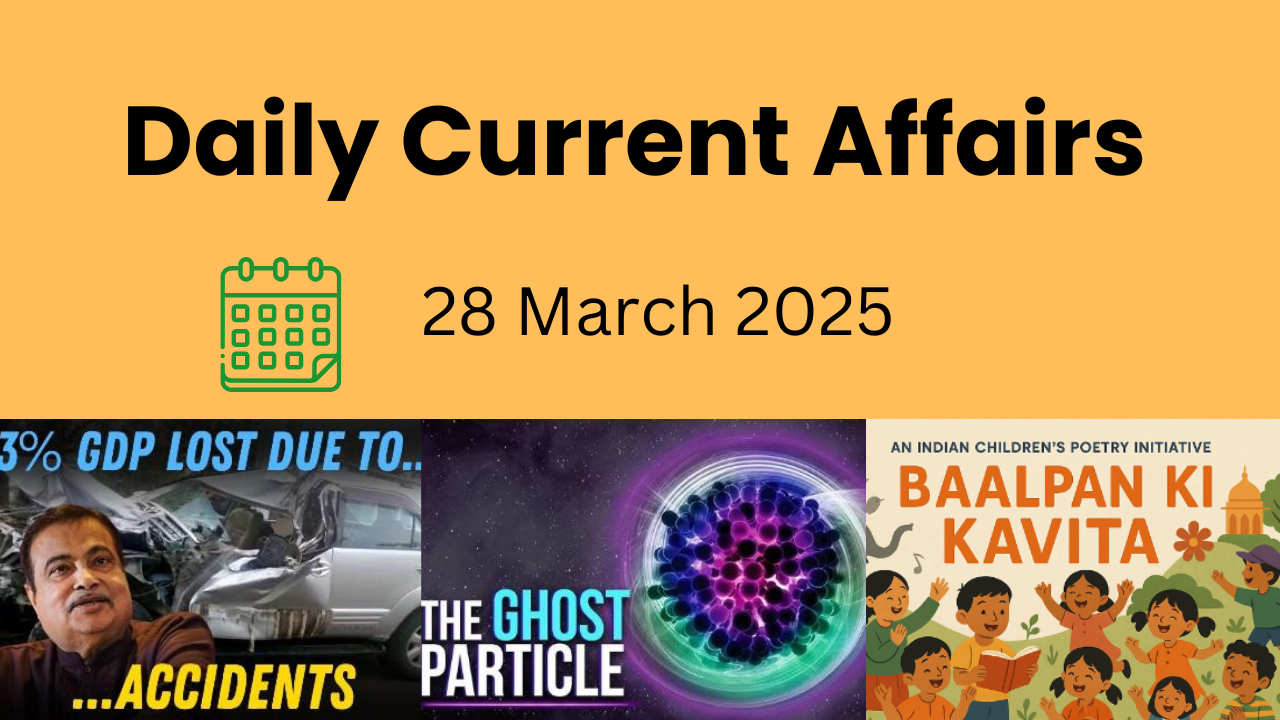1. India Losing 3% of GDP Annually Due to Road Accidents
Context: India faces a huge economic setback, losing 3% of its GDP annually due to road accidents. The Minister of Road Transport and Highways has highlighted that around five lakh accidents occur every year, leading to substantial financial and human losses.
Road Accidents in 2022: A Grim Reality
- Total Accidents: 4,61,312
- Injuries: 4,43,366
- Fatalities: 1,68,491
- Increase Compared to 2021:
- Accidents: 11.9%
- Deaths: 9.4%
- Injuries: 15.3%
- Accident Severity (Deaths per 100 Accidents): 36.5 in 2022, down from 37.3 in 2021
- Victim Demographics:
- 66.5% of victims were young adults (18-45 years)
- 83.4% of fatalities were from the 18-60 age group
- Most Affected Vehicle Categories:
- Two-Wheelers: 44.5% of deaths
- Pedestrians: 19.5%
- Cars/Taxis/Vans: 12.5%
- Trucks: 6.3%
- Leading Cause: Overspeeding (72.3% of accidents, 71.2% of deaths)
The Economic Toll of Road Accidents:
How Road Accidents Impact GDP
- Healthcare Costs: Treatment of accident victims burdens healthcare infrastructure.
- Infrastructure Damage: Accidents damage roads and public property, requiring costly repairs.
- Loss of Productivity: Many victims suffer temporary or permanent disabilities, reducing workforce efficiency.
- Higher Insurance and Legal Costs: Increased claims and legal disputes strain financial resources.
- Reduced Tourism & Transport Efficiency: Unsafe roads deter travelers and disrupt commercial transport.
- Loss of Human Capital: The deaths of young and working-age individuals negatively affect economic growth.
Government Initiatives to Enhance Road Safety:
Key Policies and Measures
- National Road Safety Policy (2010): Focuses on better road infrastructure, strict law enforcement, public awareness campaigns, and enhanced emergency care.
- Electronic Detailed Accident Report (e-DAR) & Integrated Road Accident Database (iRAD): Centralized platforms for data collection and analysis to improve safety strategies.
- Swift Assistance to Accident Victims:
- 25,000 reward for Good Samaritans helping accident victims.
- Compensation: 2.5 lakh for grievous injuries, 5 lakh for fatalities.
- Hit-and-Run Compensation: 2 lakh for fatalities, 50,000 for grievous injuries.
- Vehicle Fitness & Inspection Centers:
- Old and unfit vehicles contribute to accidents.
- The government is establishing model Inspection and Certification Centers across 28 States/UTs by 2024 to ensure roadworthiness.
- IIT Madras Collaboration: Establishing a Center of Excellence for Road Safety to drive research and innovation in safety measures.
- Accident Blackspot Rectification: Identifying and improving accident-prone zones on national highways.
- Mandatory Road Safety Audits: Ensuring all highway projects undergo safety evaluations at design, construction, and operation stages.
- Motor Vehicles Amendment Act (2019): Enforced stricter penalties for traffic violations like overspeeding, drunk driving, and not wearing helmets or seat belts.
India’s Global Commitments to Road Safety
- Decade of Action for Road Safety (2021-2030): A UN initiative to reduce global road deaths by 50% by 2030.
- Brasilia Declaration (2015): India joined 100+ nations in committing to the Sustainable Development Goal (SDG) 3.6, aiming to halve road accident fatalities by 2030.
The Road Ahead: Learning from Global Best Practices
- Adopting the Systems Approach:
- Countries like Australia and Sweden have successfully reduced accident fatalities by integrating systematic safety policies.
- India can implement similar models to achieve its target of 50% reduction in fatalities.
- Leveraging Indian Research Institutions:
- Institutes like IITs and the Central Road Research Institute (CRRI) have conducted extensive research on road safety.
- The government can collaborate with these institutions to design and implement data-driven safety policies.
- Corporate Sector Involvement:
- Companies can fund research, support awareness campaigns, and promote road safety initiatives.
Conclusion
India faces an urgent need for stronger road safety measures to curb economic and human losses from road accidents. Adopting global best practices, strengthening enforcement, leveraging technology, and fostering collaborations will be key to reducing fatalities and securing economic stability.
2. Permafrost Melting: A Rising Environmental Threat in the Kashmir Himalayas
Context: A recent study published in Remote Sensing Applications: Society and Environment has shed light on the alarming impact of permafrost degradation in the Jammu & Kashmir (J&K) Himalayas. With climate change accelerating global warming, the melting of permafrost poses serious environmental, infrastructural, and security risks in this ecologically fragile region.
Understanding Permafrost and Its Importance:
Permafrost refers to ground that remains frozen for at least two consecutive years, with temperatures at or below 32°F (0°C). It plays a vital role in maintaining ecosystem balance, regulating water cycles, and stabilizing mountain slopes. However, rising temperatures and human activities are now causing its rapid degradation, leading to severe consequences for both nature and human settlements.
Key Findings of the Study:
Extent of Permafrost in J&K and Ladakh
- 64.8% of the total geographical area of J&K and Ladakh is covered by permafrost.
- This is classified into:
- Continuous Permafrost (26.7%) – Most of the soil remains frozen.
- Discontinuous Permafrost (23.8%) – More than half of the soil is frozen.
- Sporadic Permafrost (14.3%) – Found in isolated patches.
Threat of Glacial Lake Outburst Floods (GLOFs)
- The study identified 332 proglacial lakes, of which 65 pose risks of GLOFs—a phenomenon where glacial lakes suddenly burst, causing catastrophic floods.
- Recent disasters linked to permafrost melting:
- Chamoli Disaster (2021) – A deadly flash flood in Uttarakhand, triggered by a glacier collapse.
- South Lhonak Lake Flood (2023) – A massive GLOF event in Sikkim, causing widespread destruction.
Infrastructure and Security Risks:
- Strategic roads and military installations in Ladakh are built on permafrost zones, making them vulnerable to sudden ground instability, landslides, and sinkholes.
- Thawing permafrost weakens soil stability, increasing the risk of road failures, damaged pipelines, and collapsing structures.
Hydrological and Ecological Disruptions
- Changes in River Flow: Permafrost acts as a natural water reservoir. As it melts, river flow becomes unpredictable, leading to water shortages in some areas and flooding in others.
- Groundwater Depletion: Melting permafrost alters subsurface water storage, affecting agriculture, drinking water supply, and hydroelectric projects.
What’s Causing Permafrost Degradation?
- Rising Surface Temperatures: Climate change has led to unprecedented warming in high-altitude regions, accelerating permafrost thawing.
- Natural Triggers: Earthquakes and seismic activities weaken frozen ground, leading to sudden collapses.
- Human Activities:
- Deforestation and Urbanization – Reducing land cover exposes soil to heat.
- Infrastructure Development – Construction of roads, tunnels, and dams disrupts permafrost layers.
- Tourism and Military Activities – Increased human footprint leads to environmental stress in permafrost regions.
The Way Forward: Strategies for Mitigation and Adaptation:
1. Integrated Planning for Sustainable Development
- Permafrost and cryosphere data must be integrated into infrastructure and land-use planning.
- Implementation of risk-sensitive zoning regulations to prevent construction in vulnerable areas.
2. Advanced Monitoring & Technology
- Use of satellite-based remote sensing and ground-based LiDAR technology to track permafrost degradation and its effects on geomorphological changes (such as landslides and sinkholes).
3. Strengthening Environmental Impact Assessments (EIA)
- EIA frameworks should explicitly evaluate permafrost-related risks, ensuring that projects account for potential threats like GLOFs, slope instability, and ecosystem shifts.
Did You Know?
- Permafrost stores nearly 1,700 gigatons of carbon—twice the amount present in Earth’s atmosphere! When it melts, huge amounts of greenhouse gases like carbon dioxide and methane are released, worsening global warming.
- The Arctic and Himalayas are among the fastest warming regions on Earth, making permafrost degradation a major climate crisis.
Conclusion:The melting of permafrost in the Kashmir Himalayas is not just an environmental issue but a serious socio-economic and security challenge. Urgent action is required to monitor, mitigate, and adapt to this growing crisis. Through scientific advancements, policy interventions, and sustainable development strategies, India can reduce the impact of permafrost thaw and safeguard its fragile Himalayan ecosystem.
3. Banking Laws (Amendment) Bill, 2024: Key Reforms and Parliamentary Debate
Context: Both the Lok Sabha and Rajya Sabha have passed the Banking Laws (Amendment) Bill, 2024, introducing significant changes in banking regulations, including allowing bank account holders to nominate up to four beneficiaries.
Understanding the Banking Laws (Amendment) Bill, 2024:
The Bill was introduced in the Lok Sabha on August 9, 2024, and passed on December 3, 2024. It amends five major banking laws:
- Reserve Bank of India (RBI) Act, 1934
- Banking Regulation Act, 1949
- State Bank of India (SBI) Act, 1955
- Banking Companies (Acquisition and Transfer of Undertakings) Act, 1970
- Banking Companies (Acquisition and Transfer of Undertakings) Act, 1980
Key Features of the Bill:
1. More Nominees for Deposits
- Customers can now nominate up to four beneficiaries instead of just one.
- Nominations can be made simultaneously or successively.
2. Revised ‘Fortnight’ Definition for Cash Reserves
- Banks will now calculate cash reserves using fixed calendar periods:
- 1st to 15th of the month
- 16th to month-end
- This replaces the old Saturday-to-Friday system for greater clarity.
3. Extended Director Tenure in Co-operative Banks
- Directors in co-operative banks can now serve for up to 10 years, an increase from the earlier 8-year limit.
4. Dual Directorship in Co-operative Banks
- A director in a central co-operative bank can now hold a board position in a state co-operative bank, provided they are a member.
5. Higher ‘Substantial Interest’ Threshold
- Previously, holding shares worth 5 lakh was considered substantial interest.
- The new limit is now 2 crore, reflecting inflation and market growth.
6. Unclaimed Funds Transfer to Investor Protection Fund
- Dividends, shares, and bond payments unclaimed for over seven years will now be moved to the Investor Education and Protection Fund (IEPF).
7. Autonomy in Auditor Payments
- Banks will now independently decide their auditors’ remuneration, removing the earlier dependence on RBI and the Central Government.
Parliamentary Debate and Key Arguments:
Government’s Stand
Finance Minister Nirmala Sitharaman defended the Bill, stating it strengthens banking regulations and improves customer experience. Key arguments made by the government:
- Public Sector Banks (PSBs) recorded 1.41 lakh crore profit in FY 2023-24.
- Non-Performing Assets (NPAs) have significantly reduced under financial reforms.
- 912 bank fraud cases involving wilful defaulters are under investigation by the Enforcement Directorate (ED).
- Loan write-offs are accounting measures, not waivers—banks continue pursuing recoveries.
Opposition’s Concerns
1. Wilful Defaulters & Loan Write-offs:
- The Indian National Congress (INC) criticized the 87,000 crore loan write-off linked to 50 wilful defaulters, including names like Mehul Choksi and Rishi Agarwal.
- They pointed out that large corporate defaulters get write-offs, while small borrowers face severe penalties.
2. Lack of Detailed Scrutiny:
- Opposition members questioned the government’s decision to amend five banking laws at once, demanding a Joint Parliamentary Committee (JPC) review.
3. Rising NPAs in Banks:
- Critics highlighted that 10 lakh crore in NPAs has built up over the past five years, mostly due to a small group of high-profile defaulters.
4. Challenges in Rural & Co-operative Banks:
- Opposition raised concerns over:
- Over 4,000 financial frauds in co-operative banks in the last five years.
- Outdated banking technology in rural areas, increasing risks.
- The 2 crore ‘substantial interest’ limit is static and should be inflation-linked.
Government’s Counterarguments
- The Banking Laws (Amendment) Bill, 2024 will modernize banking governance and improve financial sector stability.
- The government cited post-2014 banking reforms, including:
- Wider financial inclusion through Jan Dhan accounts.
- Increased direct benefit transfers (DBTs) reducing middlemen corruption.
- Tighter regulations on loan defaulters and fraudsters.
Conclusion: The Banking Laws (Amendment) Bill, 2024 marks a significant shift in banking regulations, introducing customer-friendly provisions, governance improvements, and regulatory clarity. However, concerns about oversight, transparency, and handling of large-scale NPAs remain points of debate. The long-term success of these reforms will depend on their implementation and monitoring in the coming years.
4. Senkaku Islands Dispute: Latest Developments & Key Facts
Context: Japan has raised serious concerns over an extended incursion by Chinese Coast Guard ships near the disputed Senkaku Islands in the East China Sea. This incident marks one of the longest violations of Japan’s territorial waters by Chinese vessels, escalating tensions in the region.
About the Senkaku Islands:
Geographical Location
- The Senkaku Islands are an uninhabited island group located in the East China Sea.
- They lie approximately 90 nautical miles north of Japan’s Yaeyama Islands (Okinawa Prefecture) and 120 nautical miles northeast of Taiwan.
- These islands are known by different names:
- Japan: Senkaku Islands
- China: Diaoyu Islands
- Taiwan: Diaoyutai Islands
- Internationally: Pinnacle Islands
Composition and Geology:
- The island group consists of eight main islands, including:
- Uotsuri Island (largest at 3.6 sq. km)
- Kuba Island
- Taisho Island (Kumeakashima Island)
- Kitakojima Island
- Minamikojima Island
- Tobise Island
- Okinokitaiwa Island
- Okinominamiiwa Island
- The total land area of the Senkaku Islands is approximately 6.3 square kilometers.
- They are composed of conglomerate sandstone, tuff, and andesitic lava, with coral outcroppings elevated during the Holocene era.
- The region is geologically active with volcanic features and fault lines that influence land formation.
Senkaku Islands Territorial Dispute:
Japan’s Claim
- Japan incorporated the Senkaku Islands into its territory in 1895, asserting that they were unclaimed and not administered by any other country at the time.
- After World War II, the U.S. administered the islands as part of the Ryukyu Islands before transferring control to Japan in 1972.
- Today, Japan administers the Senkaku Islands as part of Ishigaki City, Okinawa Prefecture.
China & Taiwan’s Claim
- China and Taiwan argue that the Senkaku Islands have historically been part of Chinese territory, citing old maps and records from the Ming and Qing dynasties.
- Both Beijing and Taipei dispute Japan’s sovereignty over the islands, leading to repeated tensions in the region.
Strategic Importance of the Senkaku Islands:
- Rich fishing grounds and potential undersea oil and gas reserves make the islands economically significant.
- Their location in the East China Sea gives them strategic military value.
- Control over the islands impacts exclusive economic zones (EEZs) of the countries involved.
Current Situation & Future Outlook:
- China has increased patrols near the islands, leading to frequent confrontations with Japanese Coast Guard vessels.
- Japan has strengthened its maritime security and seeks support from allies like the U.S. to counter Chinese assertiveness.
- The dispute remains unresolved, with diplomatic tensions rising over China’s persistent territorial claims.
The Senkaku Islands dispute is a flashpoint in East Asian geopolitics, with Japan, China, and Taiwan all staking claims over the territory. As tensions escalate, the region remains a focal point for maritime security and strategic interests in the Asia-Pacific.
5. Neutrinos: The Mysterious Ghost Particles
Context: The AMoRE experiment in South Korea has reported no signs of neutrinoless double beta decay (0νββ). This highly anticipated result places new constraints on the nature of neutrinos and their possible role as Majorana particles.
What Are Neutrinos?
Neutrinos are nearly massless, electrically neutral subatomic particles that interact extremely weakly with matter. They belong to the lepton family, which does not experience the strong nuclear force.
Origins of Neutrinos:
These elusive particles are produced in several high-energy processes, including:
- Radioactive decay of certain atomic nuclei
- Nuclear fusion in stars (such as the Sun)
- Supernova explosions
- Cosmic ray interactions in the atmosphere
The Invisible Travelers:
Neutrinos are the second most abundant subatomic particles in the universe, after photons. An astonishing 100 trillion neutrinos pass through the human body every second without leaving a trace!
Why Are Neutrinos So Hard to Detect?
Since neutrinos rarely interact with matter, capturing them requires:
- Extremely sensitive detectors
- Massive observation times
- Deep underground laboratories to shield from background noise
The Mystery of Antiparticles
Every elementary particle has an antiparticle, which has the same mass but opposite charge.
- Example: The electron has an antiparticle called the positron (same mass, opposite charge).
- Neutrinos also have antineutrinos, but distinguishing them is challenging since they lack an electric charge.
Could Neutrinos Be Their Own Antiparticles?
The Majorana Hypothesis:
Unlike most particles, which have distinct antiparticles, Majorana particles are their own antiparticles.
If neutrinos are Majorana particles, it could:
- Solve the mystery of matter-antimatter asymmetry in the universe
- Explain why matter dominates over antimatter
What Is Double Beta Decay?
Regular Beta Decay:
A neutron inside an unstable atomic nucleus transforms into a proton, emitting:
- An electron
- An antineutrino
Double Beta Decay (2νββ):
A rare process where two neutrons transform into two protons, emitting:
- Two electrons
- Two antineutrinos
This has been experimentally observed in certain isotopes.
Neutrinoless Double Beta Decay (0νββ):
A hypothetical process where only two electrons are emitted, and no neutrinos are produced.
If this decay occurs, it would mean:
- Neutrinos and antineutrinos are the same particle (Majorana particles).
- The experiment could reveal the absolute mass of neutrinos.
AMoRE Experiment: Shedding Light on Neutrinos
Location: South Korea
Method: Observed 3 kg of molybdenum-100 (Mo-100), an isotope known to undergo double beta decay.
Extreme Conditions: Detectors were cooled to near absolute zero to capture tiny energy shifts.
Findings:
- No evidence of 0νββ was found.
- If 0νββ exists, Mo-100 nuclei would decay in at least 10²⁴ years—a trillion times longer than the age of the universe!
- The neutrino’s mass is estimated to be below 0.22-0.65 billionths of a proton’s mass, but it is still not confirmed to be zero.
What’s Next for Neutrino Research?
Although the AMoRE experiment did not find evidence of 0νββ, it has helped refine the search parameters. Future experiments will:
- Use larger detectors with even greater sensitivity
- Observe different isotopes for 0νββ
- Continue the quest to uncover the true nature of neutrinos
The mystery of neutrinos remains unsolved, but each experiment brings us one step closer to unlocking their secrets.
6. Baalpan Ki Kavita” Initiative: Reviving the Magic of Childhood Rhymes
Context: The Union Ministry of Education has launched the “Baalpan Ki Kavita” Initiative, a unique effort to revive and preserve traditional Indian nursery rhymes. This initiative aims to create a comprehensive collection of rhymes and poems for young children in all Indian languages and English.
Objective of the Initiative:
The primary goal of this initiative is to enhance foundational learning by providing children with engaging and culturally rich poems. These rhymes will help young learners:
- Connect with Indian heritage and traditions
- Develop a joyful learning experience
- Strengthen language and cognitive skills
How to Participate?
The Ministry of Education, in collaboration with MyGov, is inviting entries from the public. Participants can contribute:
- Existing traditional rhymes
- Folklore-inspired verses
- Newly composed joyful poems
Categories for Submission:
The contest welcomes submissions under three age-specific categories:
- Pre-Primary (Ages 3 to 6)
- Grade 1 (Ages 6 to 7)
- Grade 2 (Ages 7 to 8)
Entries can be in any Indian language or English, and should reflect the cultural essence of India.
Why is This Initiative Important?
- Preserves indigenous knowledge by documenting folk rhymes and traditional poetry.
- Helps in early childhood development through rhythmic learning.
- Promotes multilingual education, in line with the National Education Policy (NEP) 2020.
Interesting Fact:
Studies show that rhymes and rhythm-based learning improve memory retention, phonetic skills, and creativity in young children. This initiative will bridge modern learning with India’s rich linguistic heritage.
Don’t Miss Out! Contribute your favorite childhood rhyme or create a new joyful poem to be a part of this national-level collection.




